Trudy J. Morgan-Cole's Blog, page 23
November 13, 2022
Urchin, by Kate Story
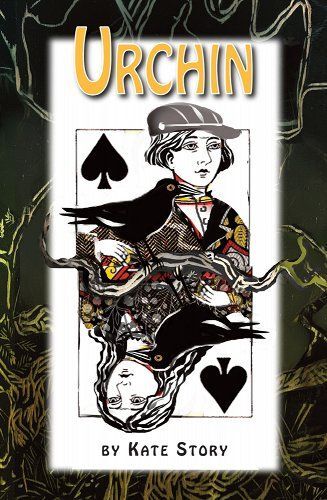
Urchin is a weird, twisty tale full of unexpected directions. It weds electricity with fairy magic in 1901 St. John’s, as Guglielmo Marconi arrives to test his new wireless technology. Thirteen year old Dorthea has plenty of worries: she doesn’t fit in at her posh girls’ school; her family is ruptured after the deaths of six siblings in infancy or early childhood; her mother is distant and her father often absent; her house is said to be built on a fairy path which might account for any number of strange occurences. Add to this the fact that Dor’s feeling of being uncomfortable in her own skin is extreme even for a pubescent girl in a society with extremely rigid gender roles: she’s never really felt “right” about being a girl, and also she’s got a pretty intense crush on her best friend. In other words, Dor has a lot to cope with even before Marconi arrives in town and a friend who is also a newspaper reporter needs a spy inside Marconi’s operation to find out what the mysterious inventor is really up to.
When Dor slips into the disguise of Jack Kelly, she finds an identity that fits far more comfortably than her own — but she also discovers that the fae activity that’s been disturbing her home is more dangerous than she suspected, and is being exacerbated by Marconi’s experiments. Fairies apparently don’t like people interfering with unseen forces like electricity, and Dor ends up fighting unexpected battles — not least, the battle to discover her own identity.
Urchin is technically a young-adult novel, and would definitely appeal to young readers who enjoy a challenging read with a blend of realism and fantasy, but it’s also a great adult read, with a vividly realized turn-of-the-20th-century St. John’s as its backdrop and an unconventional protagonist who pulls us into this tale of fairy lore, modern technology, and self-realization.
The Satsuma Complex, by Bob Mortimer
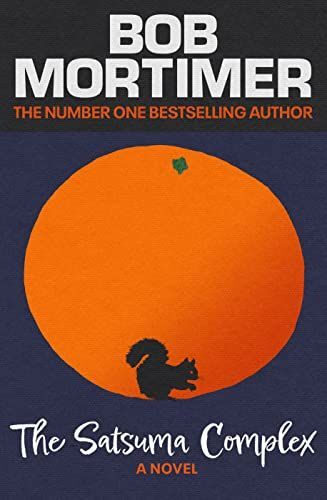
When I reviewed Richard Osman’s first mystery novel, The Thursday Murder Club, I suggested that whenever I (or many other people, I suspect) read a novel by a celebrity, I approach it with the question, “Can it really be good, or is it just popular because the author is a known name?” In the case of Osman’s mystery, my conclusion was that it was a perfectly good mystery novel, enjoyable by anyone whether they have any knowledge of mysteries or not.
Now Bob Mortimer, one of my favourite (and one of the quirkiest) UK comedians, has released his first novel, a sort of mystery/thriller, and I approached it with the same trepidation. I love Bob Mortimer so much: what if his book was a disappointment?
To cut to the chase: it was not. But I’m not entirely sure it has the same broad appeal as, say, The Thursday Murder Club, because if you’re not already a Bob Mortimer fan, you’d have to at least be a potential Bob Mortimer fan to enjoy this book, because it’s permeated with Mortimer’s sense of humour and slightly off-centre view of the world.
The main character of The Satsuma Complex is Gary, a thirty-year-old legal assistant who is not particularly thrilled about his job, his social life, or his modest London flat. In fact, Gary is, externally, a pretty dull guy — but his inner life is rich and vivid. He’s a sort of Walter Mitty-esque character, bumbling through his boring life while carrying on imagined dialogues with the squirrel he passes on his morning commute, and mentally describing everything and everyone he sees with the most unlikely similes and comparisons. “When I arrived I noticed a colourful read and white striped bicycle leant up against the wall by the entrance. It crossed by mind that there might be a pissed juggler inside the building throwing his skittles willy-nilly at the light fittings.”
Basically, to get into this novel, you have to accept that the fairly bland Gary with his bland life and bland job has the most incredibly vivid imagination and off-the-wall sense of humour. But if you’ve read Bob Mortimer’s memoir (which of course I have), you’ll know that he basically was Gary, prior to doing comedy professionally — a guy with a law degree, doing a low-level municipal job without great enjoyment or ambition, living a quiet social life badly hampered by shyness and anxiety.
Anyway, when Gary meets an acquaintance at a pub for a drink, he also meets an attractive young woman who seems to be interested in him, but who mysteriously disappears when his back is turned. Then the acquaintance he met for drinks turns up dead, possibly murdered, and we’re off with a marvellously twisty plot that I will confess I could not predict the twists and turns of at all, right up to the last page of the final chapter. I thoroughly enjoyed this book.
November 6, 2022
Small Game, by Blair Braverman
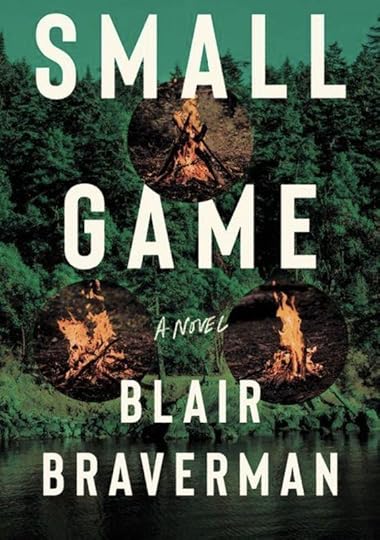
If you know Blair Braverman’s name at all, you may know her as the owner, trainer, musher, and social media representative of an exceptionally beautiful team of sled dogs (Blair and her dogs are among the few genuinely good things that Twitter has brought to our world; just something to think about as the whole thing goes into a slow-motion crash — Twitter, that is, not the dog team). She’s also an accomplished non-fiction writer, but Small Game is her first foray into fiction.
In it, Braverman draws upon her own experience both of wilderness survival, and of being a contestant on a survival-style reality show. The main character, Mara, signs up to be a contestant on a show called Civilization because she’s had loads of experience with wilderness living, her life is at a bit of a stuck place, and the $100,000 cash prize the show offers would be a big help in getting unstuck. She’s taken to a remote spot in the deep woods of the northern US (or possibly Canada; we never find out for sure where the location is) along with five other people and, of course, a camera and production crew. The contestants have to survive for six weeks; everyone who makes it to the end will be a winner.
Of course, something goes wrong.
I found this book to be as taut and tense and un-put-downable as a really good thriller. In some ways it reminded me of Elisabeth de Mariaffi’s The Retreat, in that it felt like a more thoughtful and literary take on the idea of an individual, or a small group of people, trying to survive against the odds in a deadly situation. In this case, the question the story turns on is simple: what if something went wrong, and a survival reality show became … just reality? Just survival?
Going right back to William Golding’s Lord of the Flies, which I was cursed to have to teach many, many, many years in a row, stories of this type are usually vehicles for writers to explore, not just tales of survival, but theories about human beings and how they interact. Lord of the Flies had shock value in its time because it posited that without the veneer of civilization’s structures, the raw selfishness and desire for dominance at the heart of all human beings would tear apart even a group of children — supposedly the best and most innocent of humans. Stories of this type often end up with a pretty bleak view of human nature, suggesting that when the pressure is on, people will always turn on each other.
These questions were clearly also on Blair Braverman’s mind, and will be on the reader’s mind once Mara and the other reality-show contestants find that their survival is no longer a game. I found the conclusion she reached in this story very satisfying, and the road she took to get there almost impossible to put down. A very compelling debut novel.
Ithaca, by Claire North
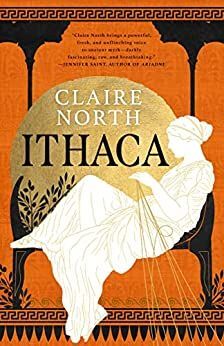
Claire North’s Ithaca is a retelling of the Odyssey focusing on Odysseus’s faithful wife, Penelope. Although Penelope is the central character, the narrator of the novel is the goddess Hera, who brings us a story of women’s efforts to defend the island kingdom of Ithaca and preserve its independence in the midst of a storm of political machinations. This is the first installment of what I guess is going to be a trilogy or duology; Odysseus hasn’t come home yet by the end of this book, but there’s already been lots of drama and intrigue. I really liked this book, and would place it alongside Madeline Miller’s Circe and Natalie Haynes’s A Thousand Ships in the category of feminist retellings that have really brought these ancient Greek myths to life for me.
Bloomsbury Girls, by Natalie Jenner
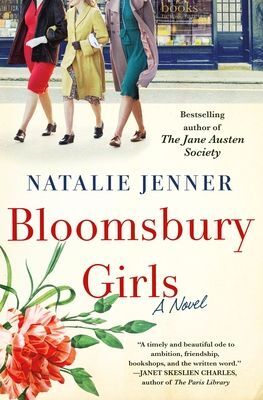
Bloomsbury Girls is, very loosely, a sequel to Jenner’s The Jane Austen Society, but only in the sense that it follows one character from that novel into her future life (other JAS characters make cameo appearances in this book, but none are central to the plot).
At the end of The Jane Austen Society Evie Stone, a brilliant girl from a poor family, had performed an amazing feat by quietly cataloguing the vast library of books in the old manor house where she worked as a servant, and was on her way to study at Cambridge due to the support and encouragement of her friends in the Society. Bloomsbury Girls picks up with Evie at the end of her college career, her path to academic advancement thwarted by the old boys’ network. Instead, the same book-cataloguing and sleuthing skills that started Evie’s academic career now lead her to a rare bookshop in London that is mired in the past while the rest of the world seems to be moving into the future. Evie needs the bookstore job to support herself, but she also has a secret mission while there.
However, the novel is just as much about the store’s other employees, particularly the other two women, aspiring novelist Vivien, and unhappily married Grace who needs the job to support her husband and two sons. Though the women are the focus, the men of the bookshop are just as intriguing, as are the cast of real-life writers and publishing people from 1950 London who make fictional cameos in this book. I really enjoyed this perspective on the lives of working women and the book business in postwar London.
The Boudica series, by Manda Scott
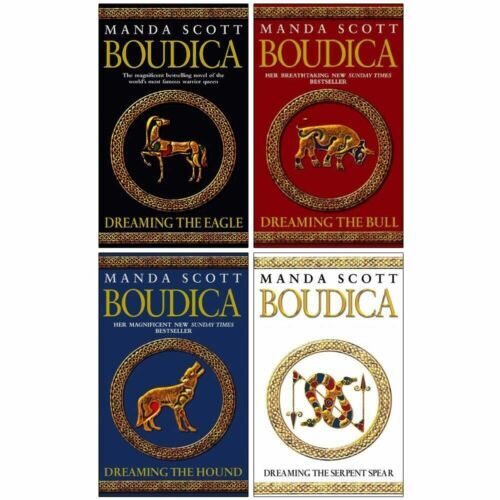
Having seen this series recommended online a few times, I checked the first book (virtually) out of the library to take on vacation with me. After reading it, I immediately wanted to get back into reliable wifi range, which was sketchy for a lot of our vacation, so that I could download the rest of the books and finish the series.
This is a fictional re-creation of the life of Boudica/Boadicea, a queen or warrior leader among the early Britons who resisted the Roman invasion — unsuccessfully, but she more than gave the Romans a run for their money. But it’s so much more than that. It’s a vividly reimagined picture — based on archeology, and on extrapolation from indigenous group in other places, along with a healthy dose of imagination — as to what the lives of people in Britain might have been like before the Roman invasion, and how the Iceni (Boudica’s tribe) and other tribes might have experienced and resisted that invasion (and not always resisted — as always with invasions, there were some collaborators as well, British tribes who gambled that their best hope of survival might be to cooperate with the Romans). It’s peopled by a huge cast of characters, all the main ones vividly drawn and memorable, especially Boudica herself and her brother Ban, kidnapped at a young age, raised among Romans, and torn by divided loyalties.
There are huge fictional leaps here — the biggest one being that the author imagines the two towering figures of British resistance, Boudica and the Catuvellauni leader Caractacus/Caradoc, as knowing each other and having a close relationship. Both are mentioned separately in Roman accounts of the invasion, conquest, and resistance of Britain, but given the relationships amongst the different tribes and how they both clashed with each other, and worked together against the foreign invader, as Scott has imagined their world, it doesn’t strain credibility too much. I got completely caught up in this series and really enjoyed it.
November 5, 2022
The Seven Husbands of Evelyn Hugo

I read this book months ago — over the summer — but I didn’t post a review because Emma and I ended up recording a podcast about it. We did one of our “Bookswap!” features where we each recommended the other read a book, and Emma recommended I read this one. So if you want to know what I thought about Evelyn Hugo and her seven husbands, have a listen.
October 15, 2022
Haven, by Emma Donoghue
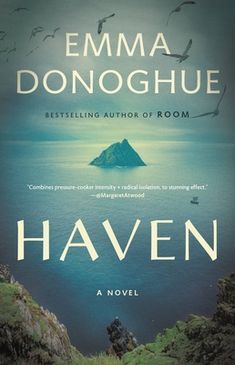
Irish/Canadian novelist Emma Donoghue is one of those rare writers (my good friend Michelle Butler Hallett is another) whose novels exhibit a startling diversity of subject because she writes about literally whatever pops into her head to be interested in. There’s no “finding a groove and sticking with it” as many of us do, for an author like Donoghue. Emma Donoghue books I have loved have touched on topics ranging from Victorian divorces, to an 1876 smallpox epidemic in San Francisco, to a contemporary story about a woman and child held captive in a tiny room — probably her most commercially successful and best-known work. Donoghue could have followed up the massive success of Room by writing more contemporary fiction about victims of crime, but instead she continued to delve into dusty corners of the past such as an Irish girl allegedly surviving miraculously for months without eating, and a lesbian love story amid the chaos of the 1918 influenza epidemic (The Pull of the Stars, coming out in the summer of 2020, proved to be surprisingly timely, but only by accident — even if the timeline weren’t so tight, Donoghue is not an author you would ever accuse of writing a “pandemic novel” just to capitalize on current events).
All this lead-in is just to say that I will follow Emma Donoghue pretty much anywhere her fancy takes her, even if it takes her to an isolated, unpopulated island off the coast of Ireland in the 7th century CE. The place is Skellig Michael, where monastic communities have existed for centuries (it was the film setting for Luke Skywalker’s monastic-style retreat in the later Star Wars movies). But this novel is not based on the real history of any of those communities. Rather, it’s a story about three men: a single-minded, visionary monk, and the two companions he recruits in response to what he believes is a call from God to leave the monastery and set up an even more isolated contemplative community, far from any human interactions, in what some might call a God-forsaken place. The visionary monk, Artt, believes passionately that as God has called them to the island, God will provide everything they need to live there — a vision that inevitably clashes with the day-to-day realities the other two monks face as they try to keep themselves and Artt alive through the winter. I read most of this novel in a single night and found it engrossing and thought-provoking,.
The Bullet That Missed, by Richard Osman
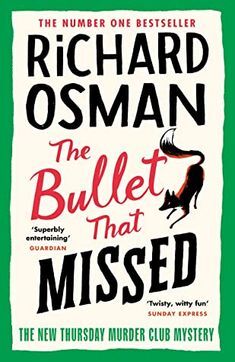
In this latest installment of the Thursday Murder Club series, retirement home residents Elizabeth, Joyce, Ron and Ibrahim (who we’ve previously met in The Thursday Murder Club and The Man Who Died Twice) are solving a cold case from several years ago while dealing with a series of present threats connected both to their previous cases and to Elizabeth’s past career in intelligence work. I always enjoy Osman’s books, but I’ve come to the conclusion that what I love most is not the mysteries themselves — I don’t even know if they’re very good mysteries; I think I’m not a very good mystery reader — but the characters, not just the main four but the rich cast of secondary characters, and the relationships among them, and the gentle humour that pervades these stories.
The Matchmaker’s Gift, by Lynda Cohen Loigman
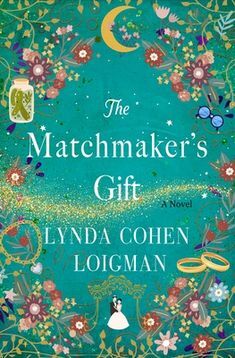
This was one of the lightest of the many books I read on my recent vacation. It’s a sweet, uncomplicated story that juxtaposes the tale of a young Jewish woman named Sara Glickman with that of her granddaughter Abby. Sara discovers her gift as a matchmaker when her family emigrates to America in 1910 and Sara finds an ideal husband for her sister on the boat crossing the Atlantic. Over the years, her ability to spot soulmates and link them up only becomes stronger, although she has to hide it for many years because the traditional male matchmakers in her community resent the interference of a young girl who doesn’t use their methods and lacks their institutional stamp of approval.
In the parallel modern day story, Sara’s grand-daughter Abby is a divorce lawyer, dealing with prenuptial agreements and messy splits between high-profile celebrity couples. But when Sara dies and Abby begins exploring her grandmother’s legacy, she also begins to develop more of an interest in connecting people than in shepherding them through their divorces.
The premise of this novel relied a little too heavily on the “soulmate” idea for me, but I loved the historical background and it was a fun read nonetheless.



